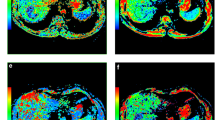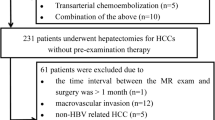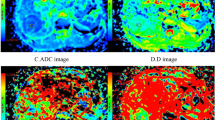Abstract
Purpose
To evaluate histologic differentiation of hepatitis B virus (HBV)-related hepatocellular carcinomas (HCCs) using apparent diffusion coefficient (ADC) and intravoxel incoherent motion (IVIM)-derived metrics and to compare findings with alpha-fetoprotein (AFP) levels alone and in combination.
Materials and method
One hundred and six chronic HBV-related HCC patients who underwent IVIM diffusion-weighted magnetic resonance imaging with eleven b values were enrolled. Mean ADC, diffusion coefficient (D), pseudodiffusion coefficient (D*), and perfusion fraction (f) values were determined for all detected lesions. The metrics and AFP levels of different histologically differentiated groups were compared. Spearman’s rank correlation was used to assess the statistical dependence among the histologically differentiated HCCs. Receiver operating characteristic (ROC) analysis was performed to evaluate diagnostic performance of these metrics and AFP levels alone and in combination.
Results
ADC, D, and f values and AFP levels were significantly different among well-, moderately, and poorly differentiated HCCs. The four metrics were significantly correlated with histologic differentiation. The area under the ROC curve (AUC-ROC) of ADC, D, f, and AFP for diagnosing well-differentiated HCCs was 0.903, 0.84, 0.782, and 0.806, respectively, and the AUC-ROC of above metrics for diagnosing poorly differentiated HCCs was 0.787, 0.726, 0.624, and 0.633, respectively. The combination of ADC and AFP provided an AUC-ROC of 0.945 for well-differentiated HCC. However, this did not provide better performance for diagnosing poorly differentiated HCC.
Conclusion
ADC, IVIM metrics, and AFP levels may be useful for evaluating histologic differentiation of HBV-related HCCs, and the combination of ADC and AFP provides better diagnostic performance for well-differentiated HCC.



Similar content being viewed by others
References
Oishi K, Itamoto T, Amano H, et al. (2007) Clinicopathologic features of poorly differentiated hepatocellular carcinoma. J Surg Oncol 95:311–316
Kaibori M, Ishizaki M, Matsui K, Kwon A (2010) Predictors of microvascular invasion before hepatectomy for hepatocellular carcinoma. J Surg Oncol 102:462–468
Okusaka T, Okada S, Ueno H, et al. (2002) Satellite lesions in patients with small hepatocellular carcinoma with reference to clinicopathologic features. Cancer 95:1931–1937
Duvoux C, Roudot Thoraval F, Decaens T, et al. (2012) Liver transplantation for hepatocellular carcinoma: a model including α-fetoprotein improves the performance of Milan criteria. Gastroenterology 143:986–994
Yaprak O, Akyildiz M, Dayangac M, et al. (2012) AFP level and histologic differentiation predict the survival of patients with liver transplantation for hepatocellular carcinoma. Hepatobiliary Pancreat Dis Int 11:256–261
Muhi A, Ichikawa T, Motosugi U, et al. (2009) High-b-value diffusion-weighted MR imaging of hepatocellular lesions: estimation of grade of malignancy of hepatocellular carcinoma. J Magn Reson Imaging 30:1005–1011
Heo SH, Jeong YY, Shin SS, et al. (2010) Apparent diffusion coefficient value of diffusion-weighted imaging for hepatocellular carcinoma: correlation with the histologic differentiation and the expression of vascular endothelial growth factor. Korean J Radiol 11:295–303
Nishie A, Tajima T, Asayama Y, et al. (2011) Diagnostic performance of apparent diffusion coefficient for predicting histological grade of hepatocellular carcinoma. Eur J Radiol 80:e29–e33
Nakanishi M, Chuma M, Hige S, et al. (2012) Relationship between diffusion-weighted magnetic resonance imaging and histological tumor grading of hepatocellular carcinoma. Ann Surg Oncol 19:1302–1309
Nasu K, Kuroki Y, Tsukamoto T, et al. (2009) Diffusion-weighted imaging of surgically resected hepatocellular carcinoma: imaging characteristics and relationship among signal intensity, apparent diffusion coefficient, and histopathologic grade. Am J Roentgenol 193:438–444
Xu H, Li X, Xie J, Yang Z, Wang B (2007) Diffusion-weighted magnetic resonance imaging of focal hepatic nodules in an experimental hepatocellular carcinoma rat model. Acad Radiol 14:279–286
Le Bihan D, Breton E, Lallemand D, Aubin M (1988) Separation of diffusion and perfusion in intravoxel incoherent motion MR imaging. Radiology 168:497–505
Dyvorne HA, Galea N, Nevers T, Fiel MI (2013) Diffusion-weighted imaging of the liver with multiple b values: effect of diffusion gradient polarity and breathing acquisition on image quality and intravoxel incoherent motion parameters—a pilot study. Radiology 266:920–929
Cohen AD, Schieke MC, Hohenwalter MD, Schmainda KM (2015) The effect of low b-values on the intravoxel incoherent motion derived pseudodiffusion parameter in liver. Magn Reson Med 73:306–311
Woo S, Lee JM, Yoon JH, et al. (2014) Intravoxel incoherent motion diffusion-weighted MR imaging of hepatocellular carcinoma: correlation with enhancement degree and histologic grade. Radiology 270:758–767
de Martel C, Maucort-Boulch D, Plummer M, Franceschi S (2015) World-wide relative contribution of hepatitis B and C viruses in hepatocellular carcinoma. Hepatology 62:1190–1200
Ashtari S (2015) Hepatocellular carcinoma in Asia: prevention strategy and planning. World J Hepatol 7:1708
Yang JD, Roberts LR (2010) Epidemiology and management of hepatocellular carcinoma. Infect Dis Clin N Am 24:899–919
Zhou Y, Si X, Wu L, et al. (2011) Influence of viral hepatitis status on prognosis in patients undergoing hepatic resection for hepatocellular carcinoma: a meta-analysis of observational studies. World J Surg Oncol 9:108
Kao W, Su C, Chau G, et al. (2011) A comparison of prognosis between patients with hepatitis B and C virus-related hepatocellular carcinoma undergoing resection surgery. World J Surg 35:858–867
Kim SY, Lee SS, Byun JH, Park SH (2010) Malignant hepatic tumors: short-term reproducibility of apparent diffusion coefficients with breath-hold and respiratory-triggered diffusion weighted MR imaging. Radiology 255:815–823
Bruix J, Sherman M (2011) Management of hepatocellular carcinoma: an update. Hepatology 53:1020–1022
Wagner M, Doblas S, Daire J, Paradis V (2012) Diffusion-weighted MR imaging for the regional characterization of liver tumors. Radiology 264:464–472
Delong ER, Delong DM, Clarke-Pearson DL (1988) Comparing the areas under two or more correlated receiver operating characteristic curves: a nonparametric approach. Biometrics 44:837–845
Lin Y, Li J, Zhang Z, et al. (2015) Comparison of intravoxel incoherent motion diffusion-weighted MR imaging and arterial spin labeling MR imaging in gliomas. BioMed Res Int 2015:1–10
Lemke A, Laun FB, Simon D, Stieltjes B, Schad LR (2010) An in vivo verification of the intravoxel incoherent motion effect in diffusion-weighted imaging of the abdomen. Magn Reson Med 64:1580–1585
Semela D, Dufour J (2004) Angiogenesis and hepatocellular carcinoma. J Hepatol 41:864–880
Lewin M, Fartoux L, Vignaud A, et al. (2011) The diffusion-weighted imaging perfusion fraction f is a potential marker of sorafenib treatment in advanced hepatocellular carcinoma: a pilot study. Eur Radiol 21:281–290
Kakite S, Dyvorne H, Besa C, et al. (2015) Hepatocellular carcinoma: short-term reproducibility of apparent diffusion coefficient and intravoxel incoherent motion parameters at 3.0 T. J Magn Reson Imaging 41:149–156
Andreou A, Koh DM, Collins DJ, et al. (2013) Measurement reproducibility of perfusion fraction and pseudodiffusion coefficient derived by intravoxel incoherent motion diffusion-weighted MR imaging in normal liver and metastases. Eur Radiol 23:428–434
Kandpal H, Sharma R, Madhusudhan KS, Kapoor KS (2009) Respiratory-triggered versus breath-hold diffusion-weighted MRI of liver lesions: comparison of image quality and apparent diffusion coefficient values. Am J Roentgenol 192:915–922
Kim SY, Lee SS, Park B, Kim N (2012) Reproducibility of measurement of apparent diffusion coefficients of malignant hepatic tumors: effect of DWI techniques and calculation methods. J Magn Reson Imaging 36:1131–1138
Kwee TC, Takahara T, Koh D, Nievelstein RAJ, Luijten PR (2008) Comparison and reproducibility of ADC measurements in breathhold, respiratory triggered, and free-breathing diffusion-weighted MR imaging of the liver. J Magn Reson Imaging 28:1141–1148
Nasu K, Kuroki Y, Fujii H, Minami M (2007) Hepatic pseudo-anisotropy: a specific artifact in hepatic diffusion-weighted images obtained with respiratory triggering. Magn Reson Mater Phys 20:205–211
Dyvorne H, Jajamovich G, Kakite S, Kuehn B, Taouli B (2014) Intravoxel incoherent motion diffusion imaging of the liver: optimal b-value subsampling and impact on parameter precision and reproducibility. Eur J Radiol 83:2109–2113
Cercueil J, Petit J, Nougaret S, et al. (2015) Intravoxel incoherent motion diffusion-weighted imaging in the liver: comparison of mono-, bi- and tri-exponential modelling at 3.0-T. Eur Radiol 25:1541–1550
Author information
Authors and Affiliations
Corresponding author
Ethics declarations
Funding
Supported by the National Natural Science Foundation of China (81271562) and Science and Technology Program of Guangzhou, China (201704020016).
Conflict of interest
The authors declare that they have no conflict of interest.
Ethical approval
All procedures performed in studies involving human participants were in accordance with the ethical standards of the institutional and/or national research committee and with the 1964 Helsinki Declaration and its later amendments or comparable ethical standards. For this type of study, formal consent is not required.
Informed consent
The Institutional Review Board approved the study and did not require additional informed consent for reviewing the patients’ medical records and image.
Rights and permissions
About this article
Cite this article
Shan, Q., Chen, J., Zhang, T. et al. Evaluating histologic differentiation of hepatitis B virus-related hepatocellular carcinoma using intravoxel incoherent motion and AFP levels alone and in combination. Abdom Radiol 42, 2079–2088 (2017). https://doi.org/10.1007/s00261-017-1107-6
Published:
Issue Date:
DOI: https://doi.org/10.1007/s00261-017-1107-6




